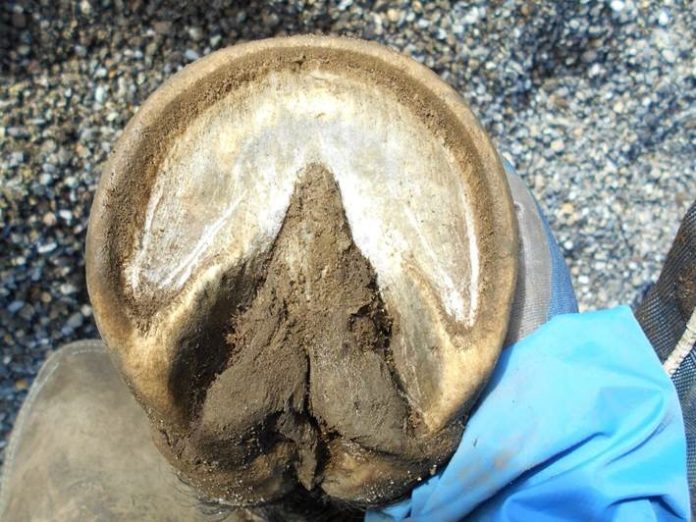Submitted by Ruthie Thompson-Klein, Equine Balance Hoof Care
Here at 48 degrees North, off the coast of Washington, our winters are usually mild and temperate, with lots of wind, occasional brief snow, and plenty of sideways rain. This is a wimpy winter compared with many across the country. Best management strategy for healthy hooves is usually “a dry place to stand out of the wind.”

This 2018 out-of-character winter has brought multiple days of below freezing temps following epic rainfall. What we got was impromptu skating rinks, slippery slopes and nail-sharp footing. During a typical couple months of winter appointments I cataloged some of our challenging conditions and ways owners cope.
My clients are on 5 to 6 week trim rotations through winter and most feed high-quality forage supplemented with balanced minerals. High immunity and tight keratin bonds only go so far. Two places we fall short for healthy hooves are movement and moisture balance. When daily hoof care slips that adds to the problem. Despite best efforts, some horse owners are coping with thrush and abscesses by February. Clients with heavy-use tracks had other challenges: wind-thrown trees, flooding, mud slicks and ice rinks.
Here are some examples of hooves, environments, puzzles and solutions:

Heavy use track with mud and drainage issues.

This becomes a hazard when the temperatures drop.
Our islands are “piles of rock” with a clay layer and thin topsoil reaches saturation point early in winter. Though annual rainfall in this part of Washington averages 25 inches, rainfall either drains slowly or creates new pasture lakes. Hooves tend to be sponge-like unless owners invest in mud control or hard-scape footing.

Solution: scrape topsoil away and apply 5/8” gravel with fines. Horses will compact surface. Adding a Geotex fabric layer between soil and gravel would improve surface durability.

January with 6 inches of gravel, snow and mud are no longer a hazard.

Heavy use track with serious mud and flooding.

Same heavy use track, now with drainage swale (right) and deep wood chips from trees removed.

Before making footing and diet improvements, this thoroughbred’s right front is unraveling despite routine hoofcare.

Same horse this February: left front before trim at 4 weeks, a much more resilient hoof on the improved footing shown above.

Arabian Belle lives on deep medium-size gravel with limited pasture turnout.

Belle before trim at 6 weeks in February. She needs attention to that frog crevice, but this could be a poster hoof for successful winter hoofkeeping.

Quarter horse Lucy before January trim at 6 weeks. Check out those solid heels and bars.

Lucy shelters in pea gravel, and spends winter in a sand and rock chip sacrifice area.

Sandy sacrifice area is gently sloped and slow draining, but deformable surface encourages movement and gentle hoof abrasion.

Easily available wood chips make a forgiving, drainable surface as long as they don’t become saturated. Composting wood chips are acidic and may unravel hoof wall. Wood chips or “hog fuel” are a semi-permanent solution, as they degrade over a few seasons.

Before trim at 6 weeks. Two horses who get regular trims, but sporadic daily hoof care, no balanced minerals and no respite from saturated conditions. Bacterial and fungal opportunists have prevailed and we have problems.

What’s going on? Horses on abrasive footing maintained beautiful distal hoof wall, plump frogs, and many grew robust bars for extra support. Horses with no respite from the constant moisture developed deep central sulcii and white line voids. Horses with excellent diets housed 24/7 in large muddy pastures had amazingly healthy hooves. Horses kept in sacrifice areas without daily hoof care did okay until mid-winter when thrush took hold. Thin-soled horses did all right in soft conditions until the freeze, when they needed boot support. In all cases owners used Gloves or Back Country for trail riding. Sometimes they added Quick Studs for mud and slushy conditions.

A solution for frozen footing is temporary use of Cloud boots to prevent bruising. I found Clouds kept thin-soled horses moving all winter despite treacherous frost heave and rough going.
What I see is proof that the 3-pronged approach of diet-movement-trim makes a significant difference in how well hooves adapt to changing conditions. Whatever winter threw at you, Happy Spring!





